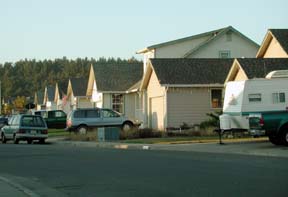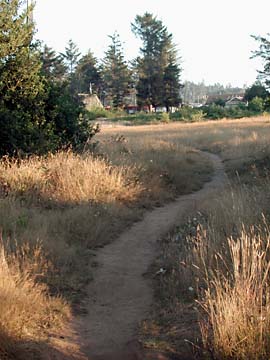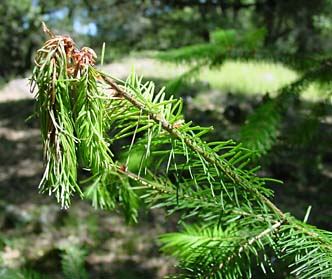| Sept. 12, 2002 How did your school do?he results of the Standardized Testing and Reporting (STAR) program's Stanford Achievement Test administered this spring in all California schools are posted at star.cde.ca.gov. The numbers represent the average scores in each grade and subject by percentile. For example, if a school's second-graders scored at the 45th percentile in reading, it means that the "average" second-grade student at that school did better than 45 percent of the nation's second-graders. To protect students' confidentiality, schools or grade levels with 10 or fewer tested students are not listed. Here is a chart showing how scores in Humboldt County compare to the state's average scores.
Planning, McKinleyville style
Welcome to land-use planning, McKinleyville style. "We all had the same vision for the community, but it got embroiled in policy language," said Jill Geist, a member of the second citizen's panel who is running this fall for the 5th District Board of Supervisors seat. "We lost sight of the vision." "Nobody expected it to take this long," added senior county Planner Tom Hofwebber. What started out as a fairly minor revision to a 1985 plan governing growth in McKinleyville and grew into a seemingly Sisyphean task is almost finished. At least, that's the hope. The Humboldt County Board of Supervisors is scheduling public hearings on the plan this month, but controversy continues to haunt the effort. Some members of the Community Advisory Committee who put in years crafting the plan said they're not certain what will be contained in the final document. That's because the county planning commission, which has had the plan under review since 1998, has made changes to the document that the committee has yet to see. "Some (Community Advisory Committee members) are concerned what the final language of the plan will look like," said Ben Shepherd, the other candidate for the 5th district seat who served on both versions of the Community Advisory Committee. One thing is clear: While the plan was bogged down by endless debate, partisan quarrelling and numerous close votes, McKinleyville -- an unincorporated community -- grew at a rate of 2.3 percent annually, almost double the county's growth rate. It would be going too far to say the growth has been rudderless. But it's at least possible that had a land-use plan been in place earlier, McKinleyville -- a one-street town flanked by a sprawl of subdivisions -- would look different today. It might look better. A sensible idea The original idea was for a group of McKinleyville volunteers to work together to come up with proposals to deal with rapid growth and urban sprawl, and to create a community identity and character for the town. The first citizen's committee was appointed in 1989. But the nine-member panel disbanded after only three years when county funds ran out. In 1995 the group was resurrected, but it doubled in size to 18 members with divergent backgrounds ranging from developers, realtors and those wanting to protect open space. The second version of the committee held its last meeting in 1998. The plan was then forwarded on to the Humboldt County Planning Commission for review. The review process has eaten up more than three years. Although most of those who volunteered to serve on the citizen's committee said it was a good learning experience, the battles, bickering and bureaucracy led many to say they wouldn't do it again. Joanie Frederick, who served on both advisory committees, felt the second committee was too large and that the county didn't give the group enough direction. After attending meetings for five years (from 1989 to 1992 and 1995 to 1997), she had enough. She felt her job was done. Frederick bowed out once the document went to the planning commission. The process didn't facilitate a lot of trust among the 18 members who made up the second advisory panel, said Geist. Geist said the group could have used a facilitator to make things run smoother. "We had 18 very diverse individuals," Geist said. Even though Geist describes the process as long and arduous, she said the committee "was able to create a document that is the consensus of the community." Several members of the Community Advisory Committee, such as Tim Hooven, said it was frustrating because of the amount of time spent going to meetings and seeing that some of the final decisions were made by the few who stuck it out to the end. Ann Ryerson, who started out as secretary for the group before replacing a member who moved, said maybe only three or four of those on the committee didn't have what she saw as a conflict of interest. Planning Commissioner Richard Hanger, from McKinleyville, said he began to see a polarization on the panel between pro- and anti-development forces early on. Adding to the overall frustration was the fact that a similar plan for the Avenue of the Giants, begun after a citizen's advisory group was formed in 1995, was completed in just two years. Hanger said it isn't fair to compare that effort to the McKinleyville plan. "The McKinleyville plan was much more complex. (It dealt with a) higher density of population and there were opportunities for differing views of opinion," he said. County support weak Even seemingly simple things, like maps, were a problem. Often the committee had to work with maps provided by the county that were printed on standard sheets of paper that were too small to be of much use. "There wasn't funding for current, accurate maps. We worked with poor quality maps. It wasn't until the end that we got better maps," said Scott Kelly, chairman of the advisory group. "We spent a lot of time discussing things (where) larger maps would have helped." Hofwebber agrees the visual support was not as good as everybody would have liked it to have been. Others, like Ryerson, said the process as designed by the county wasn't very good. The "process was very strange. (The county) had us (bickering) on policy language," she said. Supervisor Paul Kirk, who represents the 5th District which includes McKinleyville, pointed out that there was disorganization and turnover among the citizen volunteers. He acknowledged that there was also turnover among county planning staff, but said that a tremendous amount of time was spent giving the public a chance to be heard. To lay the blame on the county is "bullshit," Kirk said. "Sorry it took 12 years and (two) advisory groups," he said derisively. Bob Higgons, who represents the Northern California Association of Homebuilders, began attending the advisory committee's meetings toward the end of its work. He also followed the progress of the plan during the planning commission's review of it. Higgons said the process at the planning commission was needlessly repetitive. Sometimes the commission would take a straw vote on items in the plan and then direct Hofwebber to make changes and clarifications and bring those back for further discussion. "Sometimes it would take two or three times before the changes were put in," Higgons said. The planning commission itself went through a number of internal changes that slowed things down further, Higgons said. Half the members were not on the commission at the beginning of the work on the McKinleyville plan. Three commissioners are new this year, he added. "So they were trying to get up to speed. That compounded the situation," Higgons said. "They had to review some previous items." Fighting over trails
Kelly described the Community Advisory Committee's discussions on the trail plan as painful. The committee tried to update and weed out redundant and impractical elements of the trail plan but was bedeviled by the lack of adequate maps. "We didn't have enough information to do a good job," Kelly said, referring to the inadequate maps. "We spent a lot of time arguing, debating on where trails should go." Nonetheless, the committee -- which didn't want to lose the potential for trails with the rapid development going on in McKinleyville -- proposed almost 100 miles worth. But that mileage figure was chopped, hacked and whittled down to a level that almost all on the committee could agree with. It became clear that some of the trails were not practical because they crossed onto private property. "If you create a trail over private property, the property owner could be liable for injuries suffered on the trail. Is that fair?" asked Mark Rynearson, a Community Advisory Committee member. The Planning Commission, meantime, had proposed 70 trails in McKinleyville. That number deeply upset some people, Hofwebber said. Many trails were eliminated in the face of strong neighborhood opposition. At one of the first planning commission meetings on the McKinleyville plan, in the summer of 1999, more than 100 people showed up to voice their opinion on the trail issue -- that's how contentious the issue was. Hanger said there was resistance from some quarters to having trails in rural areas. Additionally, he said the county has refused to establish trails because it doesn't have the money to maintain the paths and doesn't want the liability. Kelly acknowledged that the trail plan isn't perfect but raised the possibility that some trails that have been removed could come up for discussion again. Geist doubted that -- which concerns her because of the rapid rate of McKinleyville's growth. "How do we address the needs of current and future residents?" she wondered. One suspects that was a pressing question when this planning process started 13 long years ago. Redwoods at risk -- and maybe much moreby ANDREW EDWARDS
One by one species were added to the list of hosts until it started to look like a native plant guide to Northern California. In January, reports appeared intimating that even the largest trees could be affected. Last Wednesday those fears were confirmed when both coast redwood and Douglas fir were confirmed to be hosts for Sudden Oak Death. [photo at right shows Sudden Oak Death disease in redwoods. Photo below left shows the disease on Douglas Fir.] The fact that the disease appears to be infiltrating on a broad front -- it has been detected on bushes such as rhododendrons and huckleberries, on small trees like madrones and manzanitas and now on the patriarchs of the forest -- has given rise to concerns that the entire forest environment could be vulnerable. "It is truly a disease at the ecosystem level," said Matteo Garbelotto, the University of California, Berkeley plant pathologist who, along with David Rizzo of UC Davis, has led the research on the new disease. While the disease is lethal to oaks, it either sickens or has no apparent effect on other species. Known by the scientific name of Phytopthora Ramorum, it is related to the blight that caused the Irish potato famine of the 1840s. It is also a cousin to the disease that wiped out American elms and American chestnuts in the early 20th century. As far as researchers can tell, the risk to redwoods appears to be limited. "A worst-case scenario would be if we saw redwood trees dying at an alarming rate (like with the oaks), and we haven't seen a single tree dying in over a 100 plots," said Garbelotto. Disturbingly, however, redwood sprouts and needle clusters can be killed by the disease. What's not clear is the extent to which mature specimens can be harmed.
Douglas fir, the most valuable timber species in the Pacific Northwest and Canada, appears to be more vulnerable. In one infected stand, the branches have been girdled and all new growth has died. The trees are in an isolated valley in Marin County and appear to be in their first year of infection. According to Ken Bovero, the owner of a Marin County tree service and the person who first broke the redwood-Sudden Oak Death connection to the press, seven or eight redwood stands in Marin have experienced dramatic diebacks. Garbelotto disputed this, saying that though P. Ramorum had been detected in several of the trees Bovero mentioned, none of them had died due to the disease. Other factors such as a less than ideal climate and other sorts of fungal infections were cited as possible culprits. Beyond being potent symbols of the North Coast, redwoods and Douglas firs are the two most economically important trees in the area. The confirmation that they are hosts for P. Ramorum could have serious implications for Humboldt County's economy. "There are potentially some very serious downsides," said Steve Hackett, an HSU economics professor who tracks the region's economic performance. Specifically, timber harvesting and shipment might be affected if and when new restrictions and quarantines on the movement of host plants are imposed, Hackett said. Because only sprouts and branches from redwoods have so far been confirmed to be infected, new regulations are likely to target them rather than the whole tree. Other possible restrictions include removing all bark on- site when a tree is cut down and limiting interstate transport to kiln-dried processed lumber, which is deemed safe. The disease itself is a cross between a fungus and a brown algae. It is extremely mobile and contagious, with a movable tail, like sperm, for swimming, as well as an ability to go airborne. It attacks trees by eating away the layer of wood directly under the bark. So far it is known to infect 17 different species worldwide, 16 of which are found in California. In addition to coast live oak, the list includes black oak, tanoak, madrones, bay laurels and buckeye, all of which are common in southern Humboldt. With varied effects ranging through all levels of the forest environment, the disease's full implications are yet to be discovered. "All of these effects (in different plants) are so different," Garbelotto said. "Are they going to affect the diversity or the health of the [entire] forest? [That's] the worst-case scenario and also the most complicated." Who is this?
The Humboldt County Coroner's Department is seeking the public's help in identifying human remains that were found in the Klamath River more than two years ago. According to Deputy Coroner Charles Jones, the remains were found in an area known as Knapps, about 15 miles up the Klamath River. The area is also known as the Old Blue Creek Lodge site. Because bark and branches were mingled with the bones, Jones believes the remains were washed down river. The remains, found in July 2000, are from a male between the age of 35 to 60. He was 5-feet-7 to 5-feet-10 in height. To help determine the identity, an Arcata artist volunteered her time to do a facial reconstruction from clay. Working with just the skull, she spent months completing a model. Although it may seem impossible to determine someone's identity with just a skull, the artist -- who asked that her name not be used -- said there are formulas for determining the depth of facial tissue and for the size of the lips, mouth and nose. "(There) is also a lot of (the) artist's interpretation," she said. "It's a blending of art and science. You use a little from each field." This is the first reconstruction the artist has done. While almost 75 percent of facial reconstruction cases do eventually get a positive response, reconstructions are usually a last-ditch effort. "The whole point is to get the reconstruction out into the public," she said. "It's sad that this guy has been sitting in the coroner's office, in a box, since 2000." Jones said the department hasn't given up on trying to learn the deceased's identity. Dental records were submitted to the California Department of Justice, but that too has proven futile. "We've had five to six (inquiries) from (the Department of Justice), but they [didn't] pan out," Jones said. "We've had no leads for over a year." Anyone who recognizes the facial reconstruction should call the Humboldt County Coroner, (707) 445-7242. -- Geoff S. Fein PL plan draws flakPacific Lumber Co.'s proposal to mine rock from a quarry near Kneeland drew a fusillade of opposition from residents at a meeting of the Humboldt County Planning Commission meeting last Thursday. Over 50 residents of the Freshwater/Kneeland area showed up to express their disapproval. It was not the mining itself that the residents found unacceptable, but the accompanying noise and truck traffic on the 20-mile haul route from the mine down through the Freshwater Valley and along congested Myrtle Avenue to the Eureka waterfront. Truck traffic on the road, which passes several schools, is already heavy from PL's logging operations. The company estimates that with the rock operation, as many as seven trucks per hour per day could be added during the work week. Parents expressed concern that PL's rock operation would place children in danger. "It's only a matter of time that a child is going to be hit by a log truck or a rock truck," said Greenwood Heights Road resident Michael Crowley. Faced with the criticism, Planning Commissioner Bruce Emad called for an independent study of PL's proposal. The commission will hold another public meeting on the matter in November. (For more, see PL Expands Gravel Mining, Aug. 15). Simpson plan draws yawnsSimpson Resource Co.'s plan to manage 430,000 acres of North Coast timberland is remarkable for how little attention it has attracted. Two public hearings held last week closed early due to light attendance. The plan, which would remain in effect for 50 years, is designed to reduce damage to the habitat of six imperiled species living on Simpson land. The species include the red tree vole, the Pacific fisher, the northern spotted owl and the coho salmon. The plan allows the company to "take" -- meaning harm or kill -- individual members of these species as long as the species' survival is ensured over the long-term. Large clearcuts would be allowed under the plan, as would herbicide spraying. That's a big issue with Yurok Indians, who consider some of Simpson's land as "ancestral gathering sites" where basket-making materials, mushrooms, acorns and other forest goods are collected to this day. Large portions of the company's holdings on the lower Klamath River are within the reservation boundaries. The plan can be viewed online at swr.nmfs.noaa.gov. Written comments can be made to Amedee Brickey of the U.S. Fish or Wildlife Service or James Bond of the National Marine Fisheries Service 1655 Heindon Road, Arcata, CA 95521 or faxed to 822-8411 by Nov. 14. Youth program in perilFaced with budget constraints, Humboldt County may cut in half the funding it gives to a program that provides crisis intervention for youths and their families. While the proposed cut would not allow funding for the program beyond December, the Humboldt County Board of Supervisors said Tuesday it will look to the General Fund to keep the youth program running through June 2003 -- the end of the current fiscal year. Since the early 1990s, the Redwood Community Action Agency-Youth Services Bureau has been the recipient of $91,600 in county funds annually. Phillip Crandall, health and human services director, proposed allocating only $45,800 toward the youth services program this year. To make matters worse, the county anticipates funds will be eliminated in the next budget cycle altogether. By at least providing six months worth of funding, it's hoped that nonprofit social service agencies throughout the county will be able to seek other funding sources to keep the youth program alive. Lloyd Throne, executive director of the Redwood Community Action Agency, said if the county cuts off funding for the Youth Services Bureau, the facility will have to close. No new patientsSt. Joseph Hospital's Family Recovery Services, which has been providing drug and alcohol abuse counseling and treatment to Humboldt County residents for 14 years, will no longer admit new patients due to a continuing county-wide health care budget crunch. Patients who are already receiving treatment will not be affected by the change. Belt tighteningHumboldt County is putting into place a new hiring review procedure for all county departments as officials struggle with a shortage of funds in the current budget. The new process will require review of all hirings by the county's personnel office, the county administrative official and the Board of Supervisors. The one-page questionnaire, which each department must fill out before officially hiring anyone, asks for the justification in hiring the new person, if the position can be part-time instead of full-time, and whether the position can be reclassified to a lower pay grade. The process will remain in effect until the Board of Supervisors has determined it can be lifted. Killer algae returnsHumboldt algae is bad, it's back and it's more insidious than ever. Last year the Journal reported that algae in Big Lagoon was killing dogs (Danger on the Beach, Nov. 29). Now river algae has turned deadly. Three dogs have died in the Eel River this year, two near Leggett and one near Garberville. The culprit is a nerve toxin produced by the algae. As a precaution, the Humboldt County Division of Environmental Health says people should avoid ingesting river water until rain and cooler fall temperatures get rid of the algae blooms. It is also recommended that children and pets should be kept out of the river altogether. Tree cutting proposedA group of Grotzman Road property owners are asking the city of Arcata for permission to clearcut one acre and cut another four acres of redwoods off of Bayside Road. The applicants' claim there is a danger of falling trees. However before any cutting can begin, Arcata planning commissioners must determine how requests to cut down trees in residential areas jibes with the city's General Plan. The plan bans commercial tree cutting in residential areas. At issue is how to allow residents to cut down trees that are clearly a hazard and at the same time avoid commercial tree harvesting camouflaged as hazard removal. Often property owners cut down trees and sell the lumber to pay for tree removal. Watching for West NileThe Humboldt County Department of Environmental Services is continuing its surveillance of dead birds now that a possible case of West Nile Virus has been reported in Southern California. However, that case in Los Angeles is still under investigation, said Brian Cox, director of environmental services. "The case in Los Angeles is a probable case," Cox said, adding that it isn't certain the woman contracted it in California. This year there have been more than 950 confirmed cases of West Nile Virus -- including 43 deaths -- nationwide. Anyone who finds a dead bird should contact the State Department of Health Services at 1-877-968-2473. West Nile Virus has flu-like symptoms such as fever, headache, achiness in the body, skin rashes and swollen lymph glands. The virus is carried from infected birds by mosquitos to horses and humans. It's overThe Biscuit fire, the biggest blaze in Oregon's history and the costliest wildfire fire nationwide this year, has finally been contained, according to the U.S. Forest Service. However, agency officials say the fire won't be fully extinguished until the rainy season begins in mid-October. The two-month old fire burned close to 500,000 acres, mostly in the rugged and remote Kalmiopsis Wilderness. Last week firefighters from across the country and as far away as Australia and New Zealand completed a 400-mile perimeter line around the fire. To date it has cost the forest service $134 million to fight the wildfire. Back in mid-August, fire-fighters corralled a small section of the fire that spread south from the Oregon border into California near Gasquet. That fire charred more than 28,000 acres and sent smoke throughout Humboldt County. Lost Coast ranch sale?A drug and alcohol abuse program with ties to the Church of Scientology is considering the purchase of the 115-acre Lost Coast Ranch, near Centerville. Narconon representatives have been speaking with Humboldt County officials about converting the 18-room house into a drug treatment site. Before the property could be turned into a drug treatment center, Narconon must go through a lengthy application process. Besides building permits, any plan for a treatment center would also require both a conditional use and coastal development permits. The Lost Coast Ranch has been for sale for some time. The owners are asking $1.7 million. Narconon, which uses the writings of Scientology founder L. Ron Hubbard in its program, has treatment centers around the world. Lodging business upFear of flying and international unrest have given a bit of a boost to the local economy, according to the July Index of Economic Activity put out by Humboldt State University. The average hotel occupancy rate for July was up more than 2 percent over July of last year. The report attributed the rise to increased travel in the United States this summer due to "fears over terrorism and financial resources." Cops looking for molesterThe Eureka Police Department is seeking the public's assistance in finding the individual responsible for molesting the 22-month-old daughter of the late Kevin LaPorta and Heather Pearce. Through DNA analysis, the police have have determined that LaPorta and two male acquaintances did not molest the girl. LaPorta, a 47-year-old Eureka acupuncturist, was killed July 19 in the kitchen of Liu's Oriental Cuisine on Fourth Street in Eureka. Pearce's mother Dianna Mae Preston has been charged with LaPorta's murder. LaPorta and Pearce were involved in a custody battle over their daughter at the time of his death. Preston is being held at the Humboldt County Jail on $1 million bond. Anyone with information on the child molestation case should contact the Eureka Police Department at 441-4307. Grand ambitionThe owners of the Lost Whale Bed and Breakfast Inn in Trinidad have a whale of a project planned for what used to be a log deck in the middle of Redwood National Park. Lee Miller and Suzanne Lakin, along with John Russavage and Mary Beswick (former Palm Springs-area residents who just moved to Trinidad) have formed Redwood Parks Lodge Co., Inc. with the intent of building a stellar vacation lodge on a 38-acre tract of land 3 miles north of Orick. The lodge, to be made out of wood, stone and glass, would be in the tradition of the lodges built at Yellowstone, Yosemite and Grand Canyon national parks by the Civilian Conservation Corps in the 1930s. Orick is a community of just over 300 people that has been known mainly for its rows of redwood-themed curio shops, and not much else. But it lies smack dab in the middle of the park, which draws over 360,000 visitors annually -- visitors who do not many lodging choices in the immediate vicinity. The partners are working with the county to get the land rezoned into roadside commercial from its current designation as industrial. With an initial investment of $30 million, which they plan to raise by selling bonds and shares of the corporation as well as securing loans, they plan to build not only a lodge, but also a roadside restaurant (a la Cinnabar Sam's in Willow Creek) and retail outlets along Highway 101. The complex would employ 120 to 200 people. According to the owners, the Park Service had planned to build a lodge on the site but had never been able to go through with it. If everything goes as planned, ground could be broken in as little as nine months, with a scheduled opening date in 2005. After the lodge is built they plan to expand the complex. Possible future additions include performing arts center and more mid-priced family accommodations. The developers say their main goal is to open up the beauties of Redwood National Park and Prairie Creek Redwoods State Park to tourists by getting them to stay for a while. "The redwoods are a national and world treasure," Miller said. "We need to preserve them and make them more accessible to the public." Comments? E-mail the Journal: [email protected] © Copyright 2002, North Coast Journal, Inc. | |||||||||||||||||||||||||||||||||||||||||||||||||||||||||||||||||||||||||||||||||||||||||||


 It has taken almost 13 years, $350,000 in taxpayer funds and more than 80 meetings. An advisory committee of citizens formed and later disbanded, to be replaced by another group even more unwieldy than the first. Pro-growth and anti-development forces wrangled, and a contentious dispute broke out over a proposed trail network. A county review process lasted more than three years -- and isn't over yet.
It has taken almost 13 years, $350,000 in taxpayer funds and more than 80 meetings. An advisory committee of citizens formed and later disbanded, to be replaced by another group even more unwieldy than the first. Pro-growth and anti-development forces wrangled, and a contentious dispute broke out over a proposed trail network. A county review process lasted more than three years -- and isn't over yet. Although the committee did manage to come to a consensus on plans for a town center for McKinleyville, for retaining open space and specific sites for residential and commercial development, "no issue evoked more controversy than trails," Shepherd said.
Although the committee did manage to come to a consensus on plans for a town center for McKinleyville, for retaining open space and specific sites for residential and commercial development, "no issue evoked more controversy than trails," Shepherd said. First the oaks started dying. Entire swaths of forest were laid waste leaving behind only gray desiccated hulks of trees covered with bleeding sores.
First the oaks started dying. Entire swaths of forest were laid waste leaving behind only gray desiccated hulks of trees covered with bleeding sores. "The truth is we don't know what it's doing in redwoods," Garbelotto said. "We're still at the stage where we're trying to understand the basic biology of the organism."
"The truth is we don't know what it's doing in redwoods," Garbelotto said. "We're still at the stage where we're trying to understand the basic biology of the organism."
